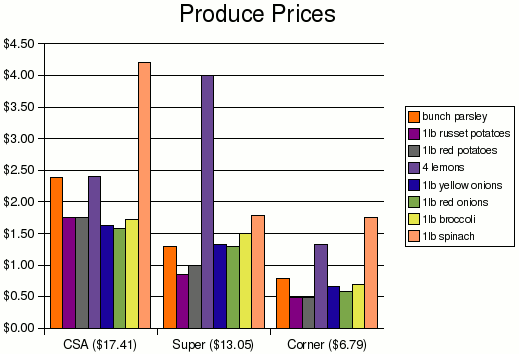As I mentioned , my sweetie and I have decided to sign up for a “Community Supported Agriculture” (CSA) program. In this program we pay a regular subscription and receive weekly deliveries of locally-grown produce at a convenient pick-up location.
I decided to do some price comparisons to try to get a feel for how much of a premium we’re paying for CSA produce.
I picked an example box of produce containing a pound each of russet and red potatoes, a pound each of red and yellow onions, a pound of broccoli, a pound of spinach, four lemons, and a bunch of parsley. Then I compared how much the items in this box would cost if I bought them through the CSA, from a nearby big-name supermarket, and from the corner vegetable market where I usually go for things like this.
You can see the results in the chart below. Except for the lemons, which were way-overpriced at the supermarket, everything is pricer at the CSA. Without exception, everything is less expensive at the corner market.

But an apples-to-apples comparison leaves out some things:
- Each of the three choices has some produce that’s hard to find at the others. The CSA has particular varieties of produce that aren’t reliably available at markets. Supermarkets tend to very reliably have the same large variety of produce year-round, and have the largest selection of the bunch. The corner market has some specialty foods particular to the ethnic cuisine of our neck of the woods, but occasionally runs out of just the thing I’m looking for.
- There are quality differences. The CSA prides itself on high-quality, organic produce. But in my experience, the produce is smaller — which is not a quality problem exactly, but it does mean that the ratio of husk/peel/skin-to-food is greater, and so we may get less edibles for our dollar. The supermarket has produce of a very uniform and blemish-free condition, and often has “organic” alternatives (usually more expensive). At the corner market, lettuce is often wilted, the broccoli battered, the onions starting to go south… I have to examine things a little more closely there before I buy.
- There are occasionally bargains. The supermarket often has 2-for-1 deals or promotional prices that are good, so if you plan your meals around these bargains you can do better than if you go in with a pre-arranged list. The corner market sometimes sells cheap bags of produce that isn’t quite good enough to sell in the regular bins, but is still salvageable. A few things, like (this week) pink lady apples, are cheaper at the CSA than at the supermarket (they’re not available at all at the corner market).
- Then there’s the whole aspect of trying not to support government-subsidized, petrochemical, centralized, long-distance agriculture. The CSA takes the guesswork out of that and keeps me from having to play detective at the grocery store. I do wonder, though, just how much that’s worth to me. It’s hard to put a price on the worth, but I have a little better idea now of the cost.
In the meat department, there’s another story. So far, we’ve ordered two meat products from the CSA: a pound each of crosscut shank and sweet Italian sausage ($5.25 and $8.50 respectively). At the supermarket, comparable hunks of animal would run $3.99 and $4.04. But having tried the sausage, which was very good, I don’t think that the supermarket alternative would measure up quality-wise. The local, corner-store-style meat markets don’t have sweet Italian sausage, and, because none of the butchers speak English very well, and I don’t speak any Chinese languages, I’d probably give up and choose another recipe before trying to ask for a cut of meat that isn’t in their display coolers.
And with grass-fed beef, or so I hear, one can avoid contributing to a bunch of additional problems regarding the ethical treatment of animals, overuse of antibiotics, and such — and, chances are, end up with a healthier and tastier slice of animal on your plate.
